Rational application developer
- 格式:doc
- 大小:39.00 KB
- 文档页数:5
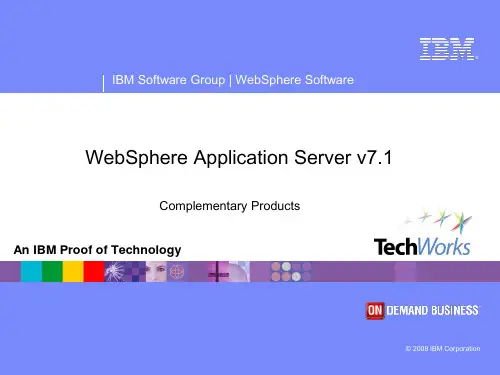
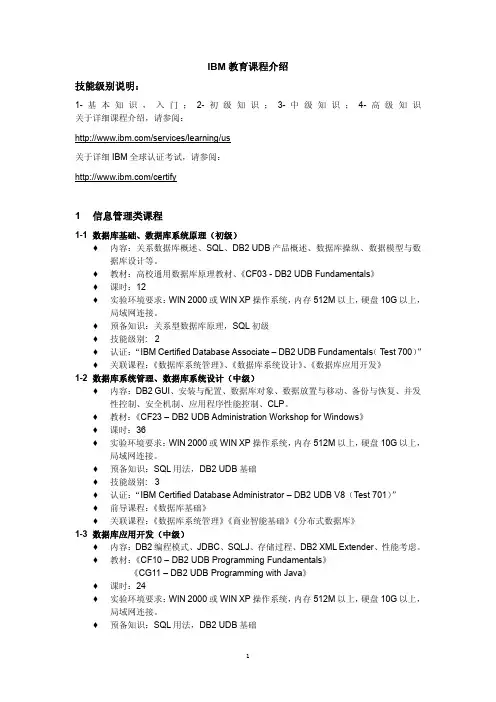
IBM教育课程介绍技能级别说明:1-基本知识,入门;2-初级知识;3-中级知识;4-高级知识关于详细课程介绍,请参阅:/services/learning/us关于详细IBM全球认证考试,请参阅:/certify1 信息管理类课程1-1 数据库基础、数据库系统原理(初级)♦内容:关系数据库概述、SQL、DB2 UDB产品概述、数据库操纵、数据模型与数据库设计等。
♦教材:高校通用数据库原理教材、《CF03 - DB2 UDB Fundamentals》♦课时:12♦实验环境要求:WIN 2000或WIN XP操作系统,内存512M以上,硬盘10G以上,局域网连接。
♦预备知识:关系型数据库原理,SQL初级♦技能级别: 2♦认证:“IBM Certified Database Associate – DB2 UDB Fundamentals( Test 700)”♦关联课程:《数据库系统管理》、《数据库系统设计》、《数据库应用开发》1-2 数据库系统管理、数据库系统设计(中级)♦内容:DB2 GUI、安装与配置、数据库对象、数据放置与移动、备份与恢复、并发性控制、安全机制、应用程序性能控制、CLP。
♦教材:《CF23 – DB2 UDB Administration Workshop for Windows》♦课时:36♦实验环境要求:WIN 2000或WIN XP操作系统,内存512M以上,硬盘10G以上,局域网连接。
♦预备知识:SQL用法,DB2 UDB基础♦技能级别: 3♦认证:“IBM Certified Database Administrator – DB2 UDB V8(Test 701)”♦前导课程:《数据库基础》♦关联课程:《数据库系统管理》《商业智能基础》《分布式数据库》1-3 数据库应用开发(中级)♦内容:DB2编程模式、JDBC、SQLJ、存储过程、DB2 XML Extender、性能考虑。
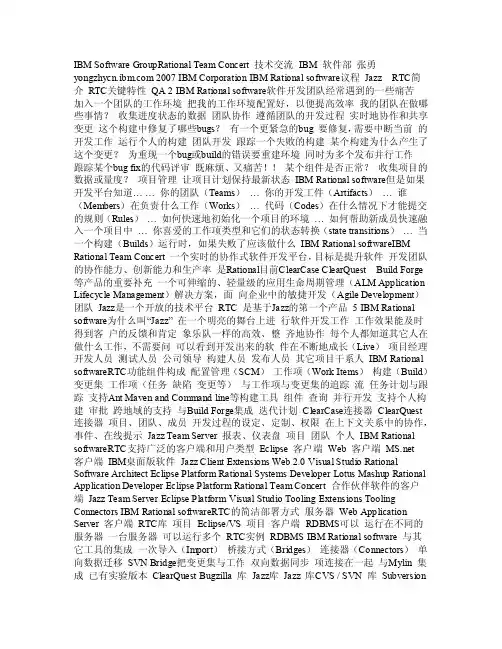
IBM Software GroupRational Team Concert 技术交流IBM 软件部张勇 2007 IBM Corporation IBM Rational software议程Jazz RTC简介RTC关键特性QA 2 IBM Rational software软件开发团队经常遇到的一些痛苦加入一个团队的工作环境把我的工作环境配置好,以便提高效率我的团队在做哪些事情?收集进度状态的数据团队协作遵循团队的开发过程实时地协作和共享变更这个构建中修复了哪些bugs?有一个更紧急的bug 要修复,需要中断当前的开发工作运行个人的构建团队开发跟踪一个失败的构建某个构建为什么产生了这个变更?为重现一个bug或build的错误要重建环境同时为多个发布并行工作跟踪某个bug fix的代码评审既麻烦、又痛苦!!某个组件是否正常?收集项目的数据或量度?项目管理让项目计划保持最新状态IBM Rational software但是如果开发平台知道… … 你的团队(Teams)… 你的开发工件(Artifacts)… 谁(Members)在负责什么工作(Works)… 代码(Codes)在什么情况下才能提交的规则(Rules)… 如何快速地初始化一个项目的环境… 如何帮助新成员快速融入一个项目中… 你喜爱的工作项类型和它们的状态转换(state transitions)… 当一个构建(Builds)运行时,如果失败了应该做什么IBM Rational softwareIBM Rational Team Concert 一个实时的协作式软件开发平台,目标是提升软件开发团队的协作能力、创新能力和生产率是Rational目前ClearCase ClearQuest Build Forge 等产品的重要补充一个可伸缩的、轻量级的应用生命周期管理(ALM Application Lifecycle Management)解决方案,面向企业中的敏捷开发(Agile Development)团队Jazz是一个开放的技术平台RTC 是基于Jazz的第一个产品5 IBM Rational software为什么叫“Jazz” 在一个明亮的舞台上进行软件开发工作工作效果能及时得到客户的反馈和肯定象乐队一样的高效、整齐地协作每个人都知道其它人在做什么工作,不需要问可以看到开发出来的软件在不断地成长(Live)项目经理开发人员测试人员公司领导构建人员发布人员其它项目干系人IBM Rational softwareRTC功能组件构成配置管理(SCM)工作项(Work Items)构建(Build)变更集工作项(任务缺陷变更等)与工作项与变更集的追踪流任务计划与跟踪支持Ant Maven and Command line等构建工具组件查询并行开发支持个人构建审批跨地域的支持与Build Forge集成迭代计划ClearCase连接器ClearQuest 连接器项目、团队、成员开发过程的设定、定制、权限在上下文关系中的协作,事件、在线提示Jazz Team Server 报表、仪表盘项目团队个人IBM Rational softwareRTC支持广泛的客户端和用户类型Eclipse 客户端Web 客户端客户端IBM桌面版软件Jazz Client Extensions Web 2.0 Visual Studio Rational Software Architect Eclipse Platform Rational Systems Developer Lotus Mashup Rational Application Developer Eclipse Platform Rational Team Concert 合作伙伴软件的客户端Jazz Team Server Eclipse Platform Visual Studio Tooling Extensions Tooling Connectors IBM Rational softwareRTC的简洁部署方式服务器Web Application Server 客户端RTC库项目Eclipse/VS 项目客户端RDBMS可以运行在不同的服务器一台服务器可以运行多个RTC实例RDBMS IBM Rational software 与其它工具的集成一次导入(Import)桥接方式(Bridges)连接器(Connectors)单向数据迁移SVN Bridge把变更集与工作双向数据同步项连接在一起与Mylin 集成已有实验版本ClearQuest Bugzilla 库Jazz库Jazz 库CVS / SVN 库Subversion库Jazz 库ClearCase Base UCM 10 IBM Rational software议程Jazz RTC简介RTC关键特性QA 11 IBM Rational softwareRTC关键特性提供高效的团队协作能力(Collaboration)支持敏捷开发,并做到适度管控(Right-Size Governance)透明化项目状态,提高项目可预见能力(Transparency Visibility)基于开放的Jazz 技术平台(Open Standard-based)实现软件生命周期的工件双向追踪能力(Traceability)集成的工作项管理,并提供灵活的定制能力(Work Item)提供了简单易用的新一代先进配置管理模式(SCM)一体化构建管理环境,集成通用的构建工具(Build Management)易于安装和管理(Low Administration)IBM Rational softwareRTC能够理解你的项目与团队项目域Project areas表示项目,描述项目信息一台服务器可以创建多个项目域团队域Team areas表示团队,描述团队信息一个项目域可以包含树状结构的多个团队域团队域管理成员Members和相应角色Roles 团队域拥有工件Artifacts 团队是自治的拥有自己的开发过程Process 拥有自己的组件Components 拥有自己的工作项Work Items 拥有自己的计划Plans 拥有自己的构建Builds IBM Rational softwareRTC优先支持团队(Team First)开发过程流成员拥有/ 提交遵循拥有工作分类构建关联团队生产监控定义仪表盘产生发布/迭代计划事件RTC理解并支持你的团队IBM Rational software项目信息透明化,加快团队信息沟通速度展示项目团队正在做什么工作:新的变化事件构建状态各位成员有哪些工作安排、工作负载、进展我的工作等等可配置的RSS Feeds:很容易加入新类型的信息个性化定制:每位成员都能根据需要进行定制按时间顺序查看每天团队发生了什么事件15 IBM Rational software基于上下文的沟通,实现高效的协作- 显示团队成员和他们的在线状态- 随时随地启动多方谈话,进行基于上下文的沟通,交谈内容可以保存在工作项中16 IBM Rational software共享变更集变更在真正确认生效之前,可以在团队成员之间共享方便团队成员之间的代码复审、讨论和其它非正式的沟通避免了因为需要在成员之间进行讨论,而在项目中把还没有完成的工作生成正式的变更记录提升沟通,加速开发进度17 IBM Rational softwareRTC关键特性提供高效的团队协作能力(Collaboration)支持敏捷开发,并做到适度管控(Right-Size Governance)透明化项目状态,提高项目可预见能力(Transparency Visibility)基于开放的Jazz技术平台(Open Standard-based)实现软件生命周期的工件双向追踪能力(Traceability)集成的工作项管理,并提供灵活的定制能力(Work Item)提供了简单易用的新一代先进配置管理模式(SCM)一体化构建管理环境,集成通用的构建工具(Build Management)易于安装和管理(Low Administration)IBM Rational softwareRTC对敏捷开发的支持对开发过程支持是中立的目前可以支持各种敏捷开发过程,例如:Eclipse Way Scrum OpenUP XP等;通常敏捷开发过程是:迭代化开发(iterative development)较短的迭代开发周期(3 – 6 星期)RTC支持多种敏捷计划方法(Agile Planning): 自顶向下制定计划(产品经理、项目主管等)自底向上(项目成员)综合自顶向下和自底向上IBM Rational software开发线与迭代开发线(Development lines)例如: 开发、维护、新产品研究不同开发线可以并行工作每个开发团队仅属于某条开发线开发线每条开发线可以包含多个开发团队开发线包含迭代迭代(阶段)迭代(Iterations)迭代可以有任意层次的结构(阶段、迭代)每个迭代都有自己的开始日期和结束日期当前迭代每条开发线只有一个当前迭代(Current Iteration)。

Rhapsody8.1.3安装手册编制人: Leo编制日期:2015年11月13日星期五Rhapsody安装手册一、 Rhapsody8.1.3客户端的安装1.Rhapsody安装前,需先预装编译器IDE,本文件是在Visual Studio2010环境下安装过程;2.插入IBM Rational Rhapsody安装光盘,直接在Windows文件夹中选择双击IBM Rational Rhapsody 8.1.3.msi。
进入Welcome to the InstallShield Wizard for IBM Rational Rhapsody 8.1.3,选择Next;3.在License Agreement中,选择I accept the terms of the license agreement,选择Next;4.在Choose Edition选择Rhapsody开发者主模块在此选择Rhapsody Developer Edition,然后点击Next;5.在Choose Languages中,选择程序语言在此选择C\C++(如果是JAVA开发就勾中JAVA等),以及Development environmentand RTOS setting(这里将自动检查你机器里面的开发环境),点击Next;6.这里选择安装路径7.机器自动识别本机安装的C语言开发工具VS2010,这里你也可以手动更改路径;8.确认其他开发环境路径;9.在Add‐on Installation中,选择合适的功能模块;本次安装过程中,可选择:Rational Rhapsody Gateway AddOn – Requirements TraceablityRational Rhapsody XMI Toolkit – XML Metadata InterchangeRational Rhapsody TestConductor AddON (测试模块TC)Rational Rhapsody Automatic Test Generation AddOn (自动测试用例生成模块ATG)Rational Rhapsody Rules Composer Add On (自定义代码生成规则)Siemens Teamcenter Systems Engineering Interface(Requires NET framework 1.1) (西门子Teamcenter软件接口,建议不安装)Automotice,AUTOSAR systems design and AutomotiveC profile (汽车领域AUTOSAR标准)Systems Engineering Add‐On (系统工程)Rational System Architect Interface (Rational System Architect接口模块)Microsoft Visual Studio Workflow Integration (VS的工作流集成)Microsoft Visual Basic for Applications (VB应用集成)10.进入License Information,设置License服务;配置有三个选项第一项是先安装,等待将来再配置;第二项配置浮动License,设置为27000@License Server HostName,点击Next;第三项配置节点锁定License,给出本地存放License文件路径,点击Next;11.确认安装信息,点击Install;12.点击Finish,完成安装;13.初次启动Rhapsody如果,前面在配置License Information时选择第一项,设置为今后配置。
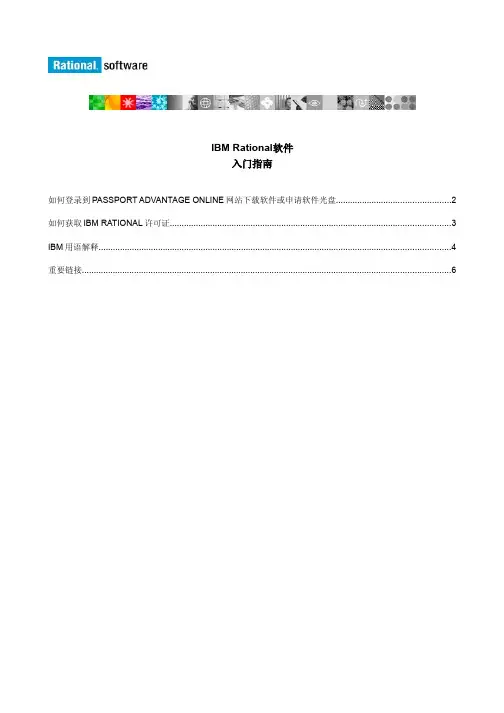
IBM Rational软件入门指南如何登录到PASSPORT ADVANTAGE ONLINE网站下载软件或申请软件光盘 (2)如何获取IBM RATIONAL许可证 (3)IBM用语解释 (4)重要链接 (6)如何登录到PASSPORT ADVANTAGE ONLINE网站下载软件或申请软件光盘如何登录到您的Passport Advantage账户1. 打开https://www-11/software/howtobuy/softwareandservices选择用户登录(Customer Sign In)”。
如果您已拥有IBM账户,请登录并进行到步骤3.2. “如果您没有IBM账户:a. “填写新用户(New Customer)“所需的信息。
,点击继续(Continue)”。
b. ”点击注册(Register)“”c. 用您的IBM账户和密码登录。
3. 如果您用自我提名来注册成为账户成员,请转到步骤4。
如果您没有用自我提名来注册:a. 输入您的实体号码(Site ID)。
请参考IBM用语解释来查看关于Site ID和Site Contact(实体联系人)的信息。
如果不是,请选择否(No)“。
b. “如果您是实体主要联系人,请选择是(Yes)””- 如果您是实体主要联系人(Primary Site Contact), 您的提名申请将发送到IBM eCustomer Care部门并由他们批准。
- 如果您不是实体主要联系人,您的提名申请将发送到主要实体联系人那里,并由他批准。
c. 当您的提名申请被批准后,您将会收到一封邮件通知。
d. 登录到您的账户: https:///software/howtobuy/softwareandservices4. 选择"Software Download and Media Access".5. 根据提示进行下一步。
如需帮助,请联系IBM eCustomer Care Team.如何获取IBM RATIONAL许可证1. 登录到IBM Rational客户支持网站的许可证部分: /software/rational/support/licensing/选择用户登录。
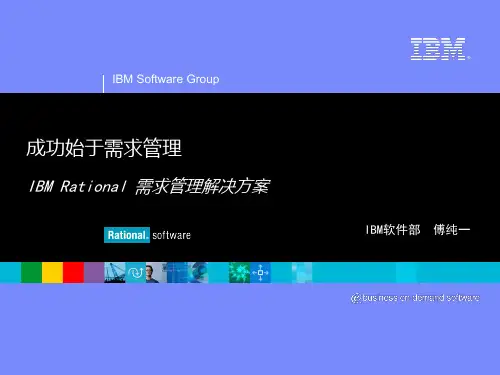
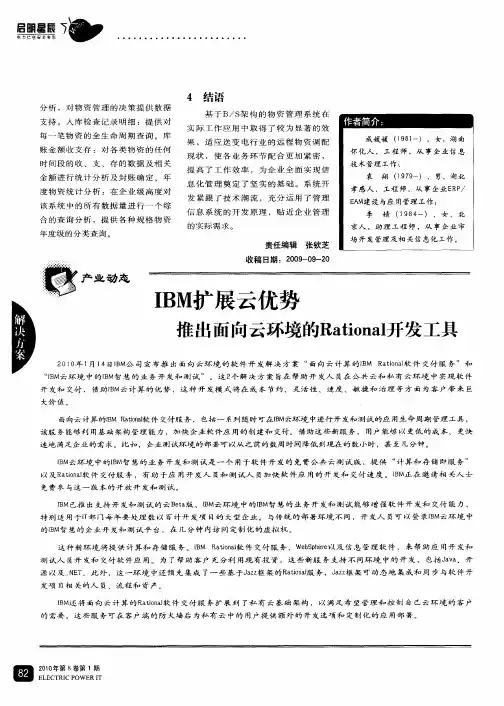
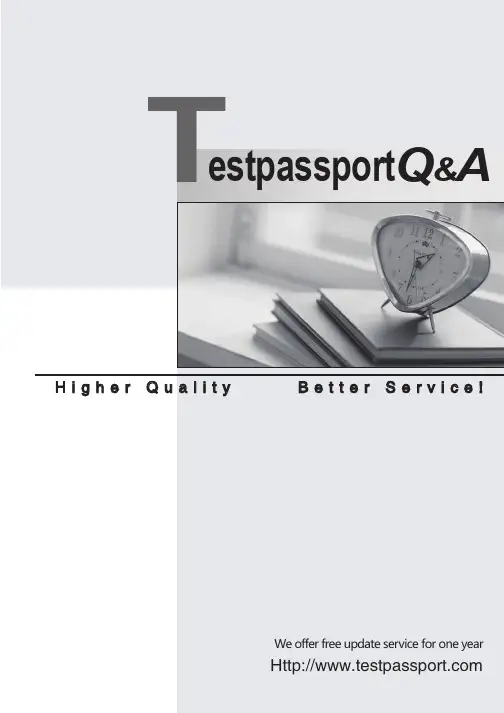
TThe safer , easier way to help you pass any IT exams.Exam : 000-377Title :Version : DemoIBM Certified System Administrator - WebSphereApplication Server NetworkDeployment V7.01. Which of the following is an option given in the First Steps application that runs automatically after installation?A.Start the server.B.Execute wsadmin.C.Configure resources.D.Run the Snoop servlet.ANSWER: A2. Which one of the following can be used to instantiate resource adapter classes for establishing and maintaining resource connections?A.a data sourceB.connection factoriesC.connection pool settingsD.a JMS activation specificationANSWER: B3. Global security is turned on for a federated cell using a file-based federated repository. The administrator created a new security domain called App1Domain using local operating system registry and mapping it to the application server. The administrator also created a new local operating system user ID App1Admin.Which one of the following is true when the new security domain is enabled to secure Application1?A.The administrator can access Application1.B.The administrator can disable Application1 security.C.App1Admin can disable Application1 security.D.App1Admin can access the administrative console.ANSWER: B4. Aside from the administrative console and the addNode command, what other facilities does WebSphere Application Server provide for federating nodes into cells?A.wsadminB.The administrative agentC.The Profile Management Tool (PMT)D.Rational Application Developer Assembly and Deploy ModuleANSWER: C5. When backing up WebSphere Application Server configuration and runtime settings, which of thefollowing commands would be relevant?A.backupConfig -location locationB.restoreConfig -profileName profile_name -backupFile backupFile_nameC.manageprofiles -backupProfile -profileName profile_name -backupFile backupFile_nameD.wsadmin -backupConfig -profileName profile_name -backupFile backupFile_nameANSWER: C6. What can the system administrator do to distribute incoming HTTP traffic across a farm of Web servers?A.Enable server affinity for each HTTP server in the clusterB.Implement the Tivoli Access Manager as a load balancerC.Implement the caching proxy server component of the Edge Componentse the Load Balancer component of the Edge ComponentsANSWER: D7. What is the sequence of components which would typically be involved in the flow of a request from a Web browser to a servlet?A.External HTTP Server, HTTP Server Plug-in and EJB ContainerB.Load Balancer, Embedded HTTP Server, HTTP Server Plug-in and Web ContainerC.Edge Component, HTTP Server Plug-in, external HTTP Server, and Web ContainerD.External HTTP Server, HTTP Server Plug-in, embedded HTTP Server and Web ContainerANSWER: D8. How could an administrator manage multiple stand-alone application servers on different hosts in a network?By using:A.a job manager which administers multiple application server nodes through administrative agents.B.a deployment manager which administers multiple application server nodes through their node agents.C.a high availability manager which administers multiple application server nodes through their administrative agents.D.an administrative agent which administers multiple application server nodes through their administrative service.ANSWER: A9. Which type of server is recommended to be placed in the demilitarized zone (DMZ)?A.Generic serversB.Application serversC.Managed HTTP serversD.Unmanaged HTTP serversANSWER: D10. What is the advantage of deploying more than one messaging engine and linking them together in a topology that has multiple interconnected service integration buses (SIBus)?A.Enable protocol transformation between buses.B.Improve the availability of the persistent storage.C.Spread messaging workload across multiple servers.D.Preserve message ordering through the messaging engines.ANSWER: C11. Why does IBM WebSphere Application Server Network Deployment utilize node groups to implementa distributed environment? To:A.segment multiple security domains within a WebSphere cell.B.define the logical grouping of application servers to scale horizontally or vertically.C.enable mixed nodes with different capabilities within the same cell for administration purposes.D.allow application servers having the same applications installed to be grouped logically for workload management.ANSWER: C12. A system administrator wants to improve response time and system load of a Web application running in a clustered environment.What might the system administrator attempt to decrease the response time of the Web application?A.Configure dynamic cachingB.Enable memory-to-memory replicationC.Configure session replication to use a database.D.Ensure that all cluster members are in the same node group.ANSWER: A13. A system administrator needs to modify the configuration of an enterprise application within a flexible management environment. The system administrator can make the modification using wsadmin scripts by connecting to which of the following components?A.Node agentB.Job managerC.Work managerD.Administrative agentE.Deployment managerANSWER: BE14. What would have to be configured in order to implement memory-to-memory HTTP Session persistence?A.Dynamic cache service and HTTP plug-inB.Synchronization service and embedded Web serverC.Distributed environment settings in the web containersD.Fast Response Cache Accelerator (FRCA) and external Web serverANSWER: C15. When configuring automated transaction peer recovery for recovering in-flight transactions from the transaction log, what is required from the file system?A.RAID disks must be used to host the transaction logB.Exclusive read only file locks and the ability to invalidate themC.File locking must be disabled for Network File System Version 4 (NFSv4)D.Lease-based exclusive locks on filesANSWER: D16. What are the three possible replication types for the dynamic caching service?A.Client modeB.Server modeC.Not sharedD.Push onlyE.Both push and pullF.Broadcast modeANSWER: CDE17. What is the Data Replication Service (DRS) used for? Please choose three from the following.A.Node agentsB.Web serversC.Caching ProxyD.Dynamic cache replicationE.HTTP session persistence and failoverF.Stateful session EJB persistence and failoverANSWER: DEF18. Which of the following statements most accurately describes the relationship between a flexible management topology and the network deployment cell?A.Flexible management can be an alternative to the network deployment cell model.B.Flexible management eliminates the need for node agents in a network deployment cell.C.The flexible management topology is a replacement for the network deployment cell.D.The flexible management job manager can perform all the tasks of the deployment manager.ANSWER: A19. In order for a deployment manager to participate in a flexible management environment, which one of the following steps must be completed?A.Register directly with the job manager.B.Register with the node agent on the job managers host.C.Register with an administrative agent on the job managers hostD.First register with a local administrative agent, and then register with the job manager.ANSWER: A20. Which of the following items best gives a reason to perform an unattended installation of WebSphere Application Server?A.The installation for the particular target platform is being done for the first time.B.The installation for the particular target platform has been done before and will be repeated in the future.C.The installation for WebSphere Application Server would initially not be able to include administrative security.D.The installation for the particular target platform is expected to require a lot of adjustments to be done over several installation attempts.ANSWER: B21. How is the response file specified in a silent installation scenario?A.Specified in the installation.properties fileB.Specified as a parameter in the launchpad user interfaceC.Included as a command-line option on the install commandD.Included as a command-line option on the launchpad applicationANSWER: C22. A system administrator has successfully installed WebSphere Application Server V7.0 and has run the Installation Verification Tool (IVT) with a success message. Which additional step can be taken to further verify the installation?A.Check to see if the InstallShield application will run again.B Check to see if the installation directory specified exists in the file system.CUse a browser to access the launch page of the IBM HTTP Server.e a browser to access the administrative console and log in successfully.ANSWER: D23. Which one of the following profile related tasks can only be performed using the manageprofiles command-line facility?A.Delete a profileB.Secure a profileC.Federate a profileD.Update profile templatesANSWER: A24. Which of the following options is NOT a valid method of running the Profile Management Tool?A.Run the command directly from a system console.B.Select Profile Management Tool from the First Steps application.C.Select System Administration -> Run Profile Management Tool in the administrative console.D.Check the Create a new WebSphere Application Server profile using the Profile Management Tool option at the end of the installation process.ANSWER: C25. A WebSphere Application Server installation finishes and the primary installation log indicates an exit code of INSTCONFSUCCESS. What is the best conclusion that can be resolved from this result?A.The Web server installed successfully.B.The WebSphere Application Server installed successfully.C.The InstallShield Wizard executed successfully to launch WebSphere Application Server installation.D.The target operating system determined that it is compatible with WebSphere Application Server and had configured environment variables for it.ANSWER: B26. A system administrator is installing WebSphere Application Server for the first time and was surprisedthat the Profile Management Tool (PMT) did not have the expected profile type options, as stated in the Information Center.What is the best conclusion for this finding?A.The Java runtime being used by the installation program is not at the required version.B.The system administrator is installing a variant of WebSphere Application Server that is not Network Deployment.C.The target operating system the system administrator is installing on is not compatible with WebSphere Application Server.D.A previous step in the installation has failed. The system administrator should cancel and check the logs before starting over again.ANSWER: B27. An administrator would like to use the Centralized Installation Manager (CIM) to install WebSphere Application Server Network Deployment V7.0 on a remote Solaris host. The Solaris host has been updated with all the required operating system patches.What is the next step the administrator must perform?A.Configure an installation target for the Solaris host.B.Download Solaris interim fixes to the CIM repository.e the Job manager to create a remote installation job.D.Copy WebSphere Application Server Network Deployment V7.0 software to the Solaris host.ANSWER: A28. An administrator has created a deployment manager profile. However, the administrator chose not to create the Centralized Installation Manager (CIM) repository and populate it with the WebSphere Application Server Network Deployment V7.0 product files.If, in the future, the administrator wants to use the Centralized Installation Manager to install WebSphere Application Server Network Deployment V7.0 on a remote host, which of the following tasks will be necessary?A.Create the CIM repository using the Installation Factory.B.Create a new deployment manager profile including the CIM repository.e the Centralized Installation Manager to create an installation target.e the Centralized Installation Manager to create an installation package.ANSWER: A29. Applications that need to create additional persistent bindings of objects associated with a specific node can bind those objects under which of the following types of namespace partition?A.Server rootsB.Cell persistentC.Node persistentD.System namespaceANSWER: C30. What is the most common role that naming plays in WebSphere Application Server?A.Allows applications to obtain references to objects such as EJB homes.B.Allows Java programs (clients and Java EE applications) to create, send, receive, and read asynchronous requests, as messages.C.Provides a runtime environment for enterprise beans within the application server.D.Provides a secure facility to support customer's basic organizational entity management needs. ANSWER: A。
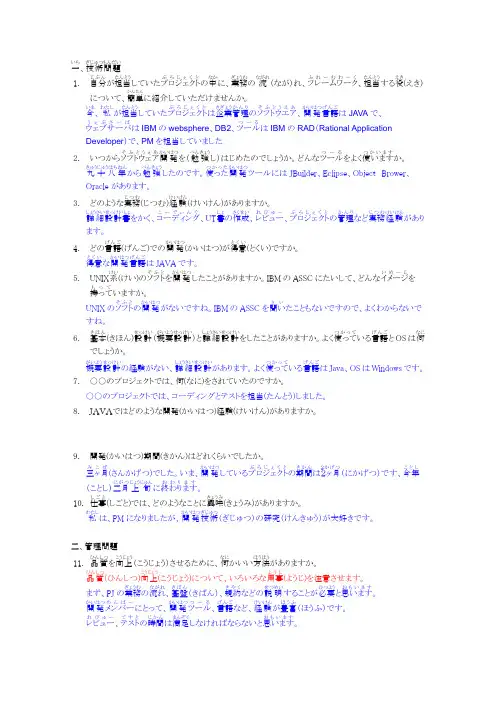
一いち、技術ぎじゅつ問題もんだい1. 自分じぶんが担当たんとうしていたプロジェクトぷろじぇくとの中なかに、業務ぎょうむの流ながれ(なが)れ、フレームワークふれーむわーく、担当たんとうする役えき(えき)について、簡単かんたんに紹介していただけませんか。
今いま、私わたしが担当たんとうしていたプロジェクトぷろじぇくとは企業きぎょう管理かんりのソフトウエアそふとうえあ、開発かいはつ言語げんごはJAVA で、ウェブサーバうぇぶさーばはIBM のwebsphere 、DB2、ツールつーるはIBM のRAD (Rational ApplicationDeveloper )で、PM を担当していました2. いつからソフトウェアそふとうぇあ開発かいはつを(勉強べんきょうし)はじめたのでしょうか。
どんなツールつーるをよく使いますつかいますか。
九十八年きゅうじゅうはちねんから勉強べんきょうしたのです。
使ったつかった開発かいはつツールにはJBuilder 、Eclipse 、Object Brower 、Oracle があります。
3. どのような実務じつむ(じつむ)経験けいけん(けいけん)がありますか。
詳細しょうさい設計書せっけいしょをかく、コーディングこーでぃんぐ、UT 書しょの作成さくせい、レビューれびゅー、プロジェクトぷろじぇくとの管理かんりなど実務じつむ経験けいけんがあります。
4. どの言語げんご(げんご)での開発かいはつ(かいはつ)が得意とくい(とくい)ですか。
得意とくいな開発かいはつ言語げんごはJAVA です。
5. UNIX 系けい(けい)のソフトそふとを開発かいはつしたことがありますか。
IBM のASSC にたいして、どんなイメージいめーじを持ってもっていますか。
UNIX のソフトそふとの開発かいはつがないですね。
IBM のASSC を聞いきいたこともないですので、よくわからないですね。
6. 基本きほん(きほん)設計せっけい(概要がいよう設計せっけい)と詳細しょうさい設計せっけいをしたことがありますか。
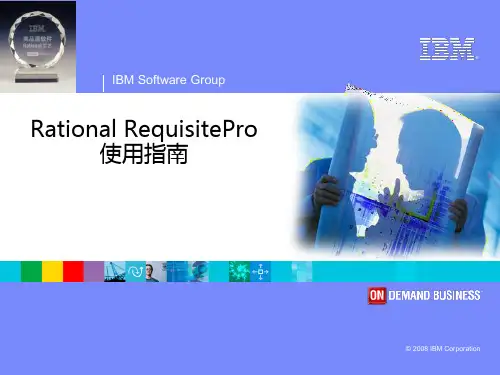
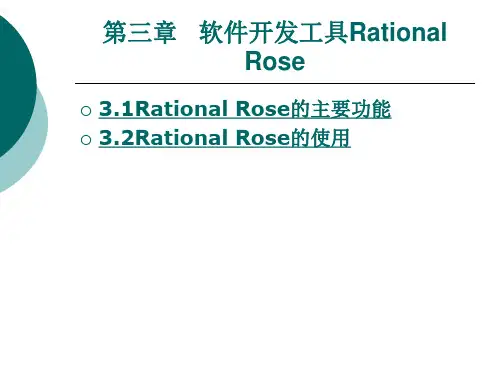
IBM developerWorks 网站IBM Rational AppScan 试用版下载及安装简介一、下载访问以下URL:/developerworks/cn/downloads/r/appscan/点击下载点击下载重要提示:这一试用版的评估试用期为30 天,具备产品的全部功能。
使用这一评估许可证(evaluation license)您可以扫描以下列出的测试Web 站点:Altoro Mutual,。
使用软件预定义的模板, 会自动显示在“New Scan”对话框中。
当弹出登录提示框时,用于登录这一测试站点的用户名及密码为:用户名(Username):jsmith密码(Password):Demo1234详情请参见后面的“第一次尝试”章节。
在“第一次尝试”章节中,我们将为您举例介绍如何配置和使用IBM Rational AppScan对该测试网站进行Web 安全扫描测试。
(您还可以访问“概述”页签了解IBM Rational AppScan 试用版的基本简介/developerworks/cn/downloads/r/appscan/learn.html)您需要使用您的IBM ID 登录下载:如果您还没有IBM ID,请访问以下网址申请:https:///account/profile/cn?page=reg登录成功后,您需要简要回答几个问题:随后将进入下载页面,您可以选择使用Download Director 下载,或使用浏览器通过HTTP 方式直接下载。
a) 使用Download Director 下载点击确认后,将会启动Download Director 进行下载:b) 使用浏览器通过HTTP 方式直接下载点击下载点击第一个“I agree”链接下载。
二、安装Rational AppScan“安装向导”会指导您快速简单地完成安装过程。
1.请关闭已打开的任何Microsoft® Office 应用程序。
Apple Developer 注册准备工作:一张visa或者万事达国际信用卡(开通visa或master功能的信用卡)、公司邮箱、公司网站(需与邮箱后缀一致)。
苹果企业开发者账号,分为两种。
第一种Enterprise Program为公司内部员工打包测试用,不可公开下载;对外发布的是第二种,为Developer Program。
一、Enterprise Program(苹果公司售价$299,约合¥1988)。
此账号的作用:企业账号是苹果给企业用户用来进行内部测试用的一种账号,我们可以通过该账号生成的证书打包APP,放于企业的内部网站上(不可上传AppStore),可供苹果用户下载安装,不过值得注意的是通过这种方式安装APP,一旦账号一年有效期到期,手机上已经安装的APP无法启动,也无法在网站上下载安装,必须重新打包发布。
因此账号按期续费非常重要。
此证书主要是没有安装设备数量限制(由于此特点,在测试和分发App 时,给开发者带来了极大的便利,尤其是多人协作)。
但是要注意:此账号仅仅用于内部测试,不可公开下载,苹果的管控是非常严格的,任何违背苹果条款使用企业账号,都会有企业账号被封的风险,封号之后使用该证书的APP将会闪退。
1、进入苹果开发者官网:https:///,拉到页面最下方,选择Enterprise Program。
2、进入Enterprise Program页面之后,再选择页面中间部分的“Get started with enrollment”(开始登记);3、跳转到What You Need to Enroll的页面,这里就是描述了一下大概需要准备什么之类的,选择下方的“Start Your Enrollment”即可。
4、若没有登录的话,随后会弹出苹果开发者账号的登录界面。
当然没有苹果账号的话,就需要去注册一个,点击“Create Apple ID”,去创建一个苹果账号。
5、创建苹果账号,需要填写一些信息,比如APPID(邮箱)、姓名(拼音)、密码(至少需要8位,含数字和大写字母)、密保问题、出生日期、国籍等。
软件学院《Rational统一过程》报告一、简答题1.(1)软件开发的六大最佳实践:●迭代式开发(Develop Iteratively)●管理需求(Manage Requirements)●基于组件的体系结构(Use Component Architectures)●可视化建模(Model Visually)●验证软件质量(Verify Quality)●控制软件变更(Control Changes)(2)它们之间的关系:第1题图六大最佳实践的关系2.RUP的二维过程结构图:第2题图:RUP二维过程结构3.RUP应用了四种模型元素:(1)工作人员(worker):谁来做●工作人员(worker)定义了个人或一个工作组的行为和职责。
●行为用活动(activity)表示,每一个“worker”都与一组“内聚”的活动相联系。
⏹内聚是指这些活动最好由一个人来完成。
●职责的表示通常与某一特定制品(artifact)相联系,这些制品由worker制造、修改和控制。
常见的工作人员有:●系统分析员:概述系统功能和界定系统;引导和协调需求,用例建模●设计师:定义一个或多个类的职责、操作、属性和它们之间的关系;决定如何调整类以适应实现环境●测试设计师:计划、设计、实现和评估测试,包括产生测试计划和测试模型,执行测试规程,评估测试覆盖度、测试结果和测试效率(2)活动(activity):怎么做●活动(activity)定义了worker执行的工作●活动有明确的目的,能够产生有意义的结果。
通常是生产制品或更新制品(如模型、类或计划)●活动时间可以是几个小时到几天●一个活动通常涉及一个worker,影响到一个或几个制品●多个活动也可能重复作用于一个制品,如从一个迭代过程到另一个迭代过程时常见的活动有:●计划迭代过程:项目经理完成●寻找用例和参与者:系统分析员完成●评审设计:设计评审员完成●执行性能测试:性能测试人员完成(3)制品(artifact):做什么●制品(artifact)是由过程生产、修改或使用的有形产品●项目在生产出最终软件产品的过程中生产或使用它们●根据与活动的关系,制品分为输入制品和输出制品常见的制品有:●模型:如用例模型和设计模型●模型元素:如一个用例、类、子系统●文档:如一个业务用例、软件架构文档●源代码●可执行文件(4)工作流(workflow):什么时候做,描述能够产出有用成果的有重要意义的活动序列,并表示出worker之间的交互作用RUP将所有工作人员和活动按涉及的领域进行逻辑分组,划分为九个核心工作流:●核心过程工作流:业务建模、需求、分析和设计、实现、测试、实施●核心支持工作流:项目管理、配置和变更管理、环境在RUP中,有一些附加的过程元素:(1)指南●工作指南:包括评审工作指南、用例研讨会工作指南●制品指南:包括建模指南、编程指南、用户接口指南(2)模板:用于制造出相应的制品(3)工具指南:介绍如何使用特定软件工具来完成每个步骤(4)概念:一些关键概念如迭代、阶段、制品、风险、性能测试4.RUP的阶段和里程碑在时间轴上的分布顺序:初始细化构造移交时生命周期目标里程碑生命周期框架里程碑最初运作能力里程碑产品发布里程碑第4题图:RUP的阶段和里程碑在时间轴上的分布顺序5.初始阶段:●确定最终产品的构想及其业务用例、并定义项目范围。
第一章 P2 1.3 J2EE的构成: 1) J2EE平台:J2EE平台主要是利用Java2平台的标准来为当前的企业级应用程提解决方案的设计,开发,装配和部署,并定义了一组核心API的标准接口。 2) J2EE规范:有相应的技术规范并对API进行解释。 3) 参考实现:是关于J2EE平台语法的正确范例。 4) 兼容性测试套件:可以是不同的J2EE版本的产品运行程序。 5) J2EE蓝图:提供了基于J2EE多层应用的实例与文档。 P3 1.4 J2EE平台角色: 1) J2EE产品提供者: 2) 工具提供者: 3) 应用程序组件提供者: 4) Enterprise Bean开发者:执行以下的任务并递交Enterprise Bean的EJB JAR文件:编写并编译源代码;详细说明部署描述;将.class文件和部署描述绑定到EJB JAR文件中。 5) WEB组件开发者:编写预编译servlet源代码;编写JSP与HTML文件;详细说明WEB组件的部署描述;将.class,.jsp,.htnl文件和部署描述绑定到WAR文件中。 6) J2EE应用程序客户端开发者:编写和编译源代码;详细说明客户端部署描述;将.class文件和部署描述绑定到JAR文件中。 7) 应用程序装配者: P4 1.5 DJ2EE体系架构(四层): 1) 客户层组件:Browser和应用程序客户端。 2) WEB层组件:JSP或Servlet。 3) 业务层组件:Entry Bean:表示数据库的表中一行永久的记录;Session Bean:表示与客户端临时交互;Message-Driven Bean:结合了Session Bean和JMS的消息监听器的特性,允许一个业务层异步接受JMS消息。 4) EIS层:企业信息系统层处理企业信息系统软件包括企业基础建设系统.. DEJB的种类:有三种企业级的Beans:实体Beans、会话(Session)Beans、消息驱动Beans。 P6 1.6 J2EE核心技术(1~7个API): JDBC:为访问不同的数据库提供了一种统一的途径; JNDI(JNDI API and JNDI SPI):Java应用程序通过其访问各种命名目录服务,服务供应商接口提供了供应商使用的功能; EJB:提供了一个框架来开发和实施分步式商务逻辑,显著的简化了具有可伸缩性和高度复杂的企业级应用的开发; RMI:更方便的完成分布式计算; Java IDL/CORBA:创建Java对象并使之可在CORBA ORB中展开,或者他们还可以创建Java类并作为和其他ORB一起展开的CORBA对象的客户。后一种方法提供了另外一种途径,通过它,Java可以用于将新应用和旧系统相集成。 JSP:JSP页面由HTML代码和嵌入其中的Java代码所组成。服务器在页面被客户端请求对这些Java代码进行处理,然后将生成的HTML页面返回给客户端的浏览器。 Java Servlet:其提供的功能大多与JSP类似,不过实现方式不同,其全部由java写成并生成HTML。(JSP通常是大多数HTML代码中嵌入少量Java代码) 第二章 P13 2.3 部署企业级应用程序步骤: 1) 路径:为企业应用程序指定.ear,.jar或.war文件的标准路径。(本地文件系统和远程文件系统)。 2) 上下文根:指定WEB应用程序的的上下文根,上下文根与定义的Servlet映射进行组合,可以组成用户以访问Servlet的完整URL. 3) 生成默认绑定: 4) 前缀:指定用于生成的JNDI名称的前缀。 5) 覆盖:指定生成的绑定是否覆盖现有绑定。 6) 连接工厂绑定:指定默认数据源JNDI名称。 7) 虚拟主机:指定WEB模块的虚拟主机。 8) 特定绑定文件:指定覆盖默认绑定的绑定文件。 第三章 P21 3.3 文件关联:为文件设置默认的打开方式。 P22 导入和导出:EAR文件,EJB JAR文件,FTP,HTTP,JAR文件,RAR文件,WAR文件,ZIP文件,文件系统,项目交换。 P25 3.4 1. 透视图和视图: 1) 透视图由视图和编辑器组成。 2) 窗口->打开透视图和在透视图显示下窗口->显示视图下为透视添加视图。 3) D默认透试图:J2EE(缺省值)、Java、Java类型层次结构、Java浏览、Web、调试、数据、资源。项目资源管理器,大纲视图,任务视图 ,编辑器(J2EE透视图) 4) 工作区管理:启动设置,rationalsdp [-data WORKSPACE]. P27 DOS命令下如何启动某个工作区:retionalsdp[-data WORKSPACE],其中WORKSPACE为工作区所在的详细目录。通过使用-data参数,用户可以迅速地在另一个工作区启动RAD主程序。 第四章 P35 什么是JDBC? P36 RAD的数据透视图: 1) 数据定义视图:显示了数据的定义与设计。 2) 数据输出视图:当在数据库对象上执行操作,或当使用DDL,SQL的时候,数据输出视图来显示操作后的输出结果(状态,对象,操作)。 3) 导航视图:显示本地的数据描述文件。 4) 数据库资源管理器视图:独立与正在进行的工程,主要负责管理数据库的连接,并显示已加载数据库连接的各项信息。 第五章 DP46,P47所有内容(生命周期方法及每个方法的工作) Servlet概述: 1) Servlet与Applet:前者没有main方法,只有写自定义的方法,后台服务,支持多线程.. 2) Servlet与CGI:方便,功能强大,可移植性好,节省资源(CGI为每一个请求启动一个进程)。 3) Servlet生命周期:加载和实例化,初始化,处理请求,服务结束。 4) Servlet方法: init():用于初始化servlet。 service():是Servlet的核心,每当一个客户请求一个HttpServlet对象,该对象的此方法就要被调用,而且传递给这个方法一个“请求”ServletRequest对象和一个“响应 ”ServletResponse对象作为参数。 doGet():当客户通过HTML表单发出一个HTTP GET请求时,此方法被调用,与GET请求相关的参数添加到URL后面,并与这个请求一起发送,当不需要修改服务器端得数据时,应该使用此方法。 doPost(): 当客户通过HTML表单发出一个HTTP POST请求时,此方法被调用,与POST请求相关的参数作为一个单独的HTTP请求从浏览器发送到服务器,当需要修改服务器端得数据时,应该使用此方法。 destroy():此方法仅执行一次,即在服务器停止且卸载servlet时。 GetServletConfig():此方法返回一个ServletConfig 对象,该对象用来返回初始化参数和ServletContext,ServletContext接口提供有关servlet的环境信息 GetServletInfo():是个可选的方法,提供有关servlet的信息,如作者版权等。 5) Servlet编程接口:P57。 DP58 使用部署描述符编辑器配置Servlet: URL映射: 初始化: 启动时装入:value 安全角色引用: 运行方式: 图标: P65 Servlet过滤器: 1) 定义:过滤器是一个程序,他先与之相关的Servlet运行在服务器上,可以检查进入这些资源的请求信息。 2) 原理:在Servlet作为过滤器使用时,他可以对客户的请求进行处理,处理完后,他会交给下一个过滤器处理。 3) 作用:查询请求并作出相应的行动,阻塞请求-响应对,使其不能进一步传递,修改请求的头部和数据,修改响应的头部数据,与外部资源进行交互。 4) 接口构成:init(FilterConfig), doFilter(ServletRequest,ServletResponse,FilterChain), destroy().filterchain参数用于访问后续过滤器。 DP72 (具体见书) MVC模式、由哪些技术实现、优点:把一个应用的输入,处理,输出流程按照Model, View, Controller的方式进行分离,这样一个应用分成三层---模型层,视图层,控制层,Model部分是业务与应用领域相关逻辑,管理状态之对象,Controller部分接受来自View所输入的资料与Model部分互动,是业务流程控制之处,View部分负责展现资料,接受使用者输入资料。 DP72 JSP内置对象及方法(见书): 1) request对象:该对象为ServletRequest的一个实例。 2) response对象:该对象对客户的请求做出动态响应,向客户端发送数据。 3) session对象:是一个JSP内置对象,它在第一个JSP页面被装载时自动创建,完成回话气管理。 4) application对象:服务器启动时就产生了这个application对象,当客户端在所访问的各个页面之间浏览时,这个application对象多是同一个,直到服务器关闭。 5) out对象:是一个输出流,用来向客户端输出数据。 6) page: java.lang.Object的实例:对应this关键字,JSP网页本身,page对象是当前页面转换后的Servlet类的实例。 7) config:javax.servlet.ServletConfig的实例,该实例代表该JSP的配置信息。 8) exception:java.lang.Throwable的实例,该实例代表其他页面的异常和错误。 9) pageContext:javax.servlet.jsp.PageContext的实例,pageContext对象提供了对JSP页面多有对象及名字空间的访问,即可以访问页面所在的session,也可以取本页面所在的application的某一属性值,相当于页面中所有功能的集大成者,它的本名也叫pageContext。 P76(全部) JSP基本语法: 1)程序片:<%= %>,<%@ %>,,<% %>。 2)JSP指令:page, include, language, extends, isErrorPage, contentPage, errorPage, import, session, isThreadSafe. P94~P96全部内容 DP101框架 DP102时序图 DP103Struts的两个核心API及其作用